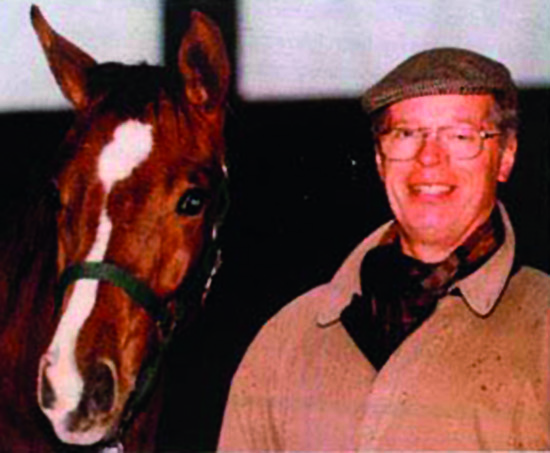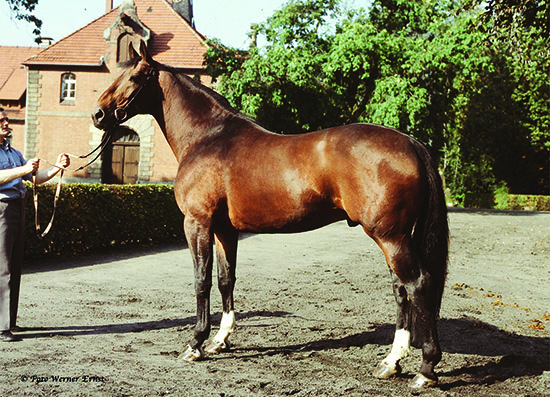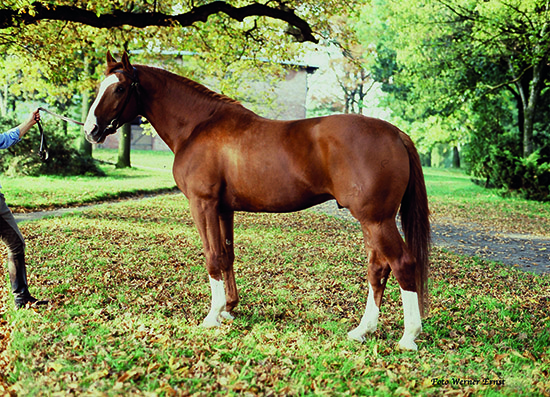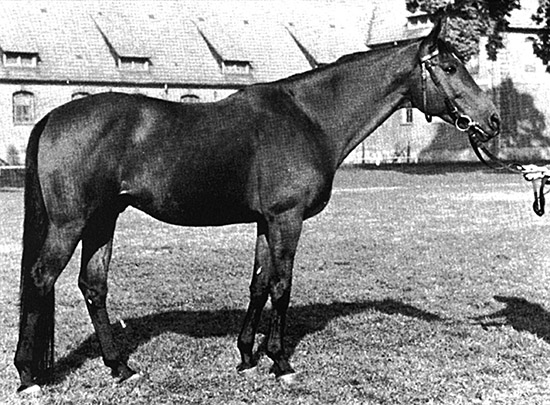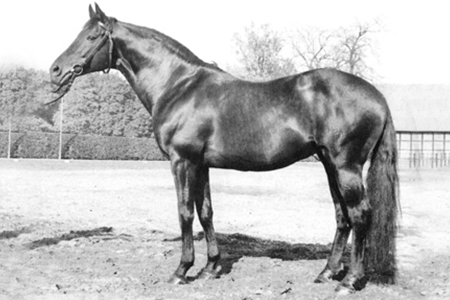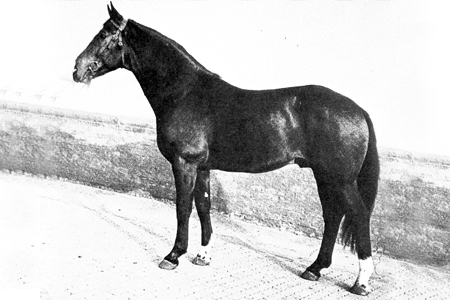Christopher Hector conducted this interview with the late Werner Schockemöhle in 1998:
“My idea as a breeder is to have a horse with the ability to do both, top dressage and top showjumping in the one horse. I think the complete horse should be able to do both. For example, Grundstein produced top dressage horses and top showjumpers. That’s breeding.”
“Normally a horse will be as good as the breeder’s ambition. It sounds a little crazy, but think a little longer about it. When the breeders try hard enough to come to the highest aim, then it is possible to reach it – that is the history of breeding all sorts of animals. You can breed what you wish, you must be clever enough, tough enough, strong enough, good enough to do it without fear of the consequences, then it is possible. But people are too lazy in the brain, they say ‘we can only breed dressage horses’ or ‘we can only breed jumping horses’. That’s wrong.”
“The horse that has good technique in showjumping, has more chance to show good piaffe/passage. In my opinion the breeders are too lazy in the brain. You must try harder. Alabaster is a good jumper too. I hate a horse that can’t jump. I hate horses that cannot show a good walk, a good trot and a good canter.”
“The most important thing is the walk. The next most important thing is the canter – and then the trot. Most people, all they look for is the trot. Often you can make the trot better with exercises, you can never make better the walk, and normally you cannot improve the canter.”
“I don’t like the specialists. I talk sometimes with the Holstein breeders and they sometimes have horses with only one gait – the canter. That, I am sure, is the wrong way. The Holsteiners are producing at the moment the best showjumpers in the world. There is no-one in the world breeding community with a better knowledge of the showjumping horse, but that is only part of the whole.”
“My opinion is that the best showjumping stallion, must have the ability to be trained up to at least ‘M’ standard dressage – on the other side, a dressage producer, he must have the ability to go to a showjumping competition up to at least level ‘M’. It is crazy to produce breeding stallions who cannot even walk, for most of the horse’s life it is walking. I say the breeders don’t try hard enough, they must work harder.”
“It is only 0.5% of horses that go to the highest level of competition, most horses must be good comfortable riding horses: good walk, good canter, clear minded – and also the horse shouldn’t be too tall. I always say, as long is the horse, as short is the life! Tall horses have many orthopaedic problems.”
“At the moment I think all German breeding societies are working together with two exceptions – Holstein and Trakehner. All the other societies in the past 30 years have used the stallions of Hanover. Now the Holsteiners are using Hanoverian blood a little bit, but the Trakehners not at all.”
“All these breeding societies are trying to breed the same horse, but not all are of the same standard. The Hanoverian is the highest standard for dressage in the world. There is not another area where you would find such a lot of good horses for dressage. Nowhere can you find so many good mares – in conformation and in gaits – as you do in Hanover. But in Hanover, for the past ten to fifteen years, they gave up on the idea to produce both dressage and jumping horses. Now they have changed the political direction, and they try again to combine it, and that is my idea.”
“In Holstein, they put it also in their official breeding credo to produce a showjumping horse – but they must come back and pay more attention to breeding for a higher standard for riding. For the normal rider, they must produce better horses, with good walk, with good trot, and with a good brain, and with good canter and good showjumping, and not eighteen and a half hands high, then the vet is always on the farm. Good showjumping alone is not possible, because if they are not good showjumpers then they are only good for slaughter.”
“A special breeder, like Leon Melchior or my brother, Paul, will produce a special horse – but to make that a breeding program for a couple of thousand people is another thing. You must produce horses that can be used by the normal rider.”
“A showjumper must be ridden like a dressage horse in his training exercises, and it must be possible for the horse to learn these exercises. I think the jumping riders who have thought a little more about this problem, would agree with me. They also like horses that are easy to work.”
“In the last twenty years, there has been real progress with some of the top riders trying to develop sport horse stallions, first as sport horses, and later to use them as stallions and make a profit out of this. You have a very famous horse in the sport, and he is a stallion, and he finishes his sport career, then he can be a very successful stallion. Sometimes they combine the two careers, For Pleasure, for example.”
When we talk about ‘type’ – if you look at some of those famous old mares, like Wolke, the mare of Dr Schulz-Stellenfleth who produced Wolkenstein I and II, then I’m not sure ‘an old fashioned’ mare like that would be welcomed today if you took her to a mare show…
” No, they probably wouldn’t like her very much. Dr Schulz is a very clever man but he is a breeder of the old sort. He is not so often at a competition – but he has top horses, with top abilities for sport.”
But my question is, if at the mare shows you keep selecting more elegant more refined, more blood type mares eventually you will lose those big old mares that have been so instrumental even with ‘modern’ stallions like Wolkenstein?
“I think it is possible to have nice types with the ability to produce top sport horses. But you never must believe that the nice type is the only way to produce the sport horse. You can only discover the sport horse by using him. He must show it. If the nice horse should be the best, then the Trakehners are the best horses!”
“I know the horses of Dr Schulz and they are not the best types, but he has produced top horses. Garibaldi, for example, I remember him well, he was a horse with a very difficult neck but he produced sport horses. Garibaldi died quite early, he had trouble with one leg – there were two Garibaldis, one and two. Garibaldi I was the bay – the important one was Garibaldi 11, the chestnut. Number one was a better type without any doubt, he was the winner of the grading. I tried to buy him on the first day of the grading. It was in the days of Dr Hartwig when Hanoverian breeders were required to sell their licensed colts to Celle for a fixed fee, and on the first day he said, ‘it is possible’, on the second day, he said ‘er er’, and on the third day, he was the winning horse, and he was for the Landstallmeister.”
Garibaldi I
“The better horse was Garibaldi II, he was not such a nice type but he produced both showjumping horses and dressage horses. The showjumping ability of Garibaldi only came from Grande. Grande was a little horse – nowadays if he came to the grading he should never be accepted I’m sure. But he had a lot of very good genes, and his sons were better than he, and the grandsons were better.”
Garibaldi II
Under the old system, the stallion was sent to the local stallion station, and the breeders used them – now the breeders can use any stallion they like, and those unfashionable stallions, that random outcross doesn’t get a chance…
“That is a very difficult question. I have been breeding horses for thirty years, and I will try to explain how in former times, a stallion came to success. He was in a local place, and was mated with his mares by natural cover. Then came foals, some were good, some average, and some not so good. The breeders had knowledge enough because the officials of the National stud told them what to do.”
“Today we have a lot of breeders who know nothing about quality, they can only see that the foal has a nice neck or a nice head but they cannot judge the whole of the foal together. In earlier times, the breeders made again the mating with the mares that produced good foals, and average foals – but never with the ones that produced bad foals. So as the years went on, the number of mares that produced good and very good foals with that stallion, became higher and higher.”
“Some stallions were not so good, and after a few years they were withdrawn. But the better horses, by this method, came to success, and the success went on for a long time, every year the number of mares that fitted with him became higher, that was a way to produce a stallion.”
“In earlier times, if I saw a pedigree, I knew where the horse had been born because I knew the stallions and where they were placed. Nowadays we are in one big breeding area, the crazy people make matings by reading books, they plan new matings when the foal is not born! In 1996 my mare comes to that famous stallion, in 97 to that famous stallion, and they don’t look at the foal. Crazy!”
“In the past, I had good connections with the people at the State Stud, and they would give me a call and say, you must come, I can show you a good colt foal. I’d go and look, and it would be a good colt foal, maybe not so good that I had to buy it, but very often I would. Today, the young people at the Stud are very good at working in a laboratory, with microscopes. They make a breeding industry but they don’t know a horse, and they say, ‘oh we’ve got a wonderful foal’, and I travel 200 kilometres, and I need to spend two seconds, then I say I must go home.”
“In former times, only the local breeder had a chance to use the famous stallions. So stallions like Ferdinand, or Absatz, they were always fully booked. Nowadays using AI, any breeder can breed to any stallion. Today, I see a pedigree, and I don’t know where the horse has been produced – and that makes breeding more difficult.”
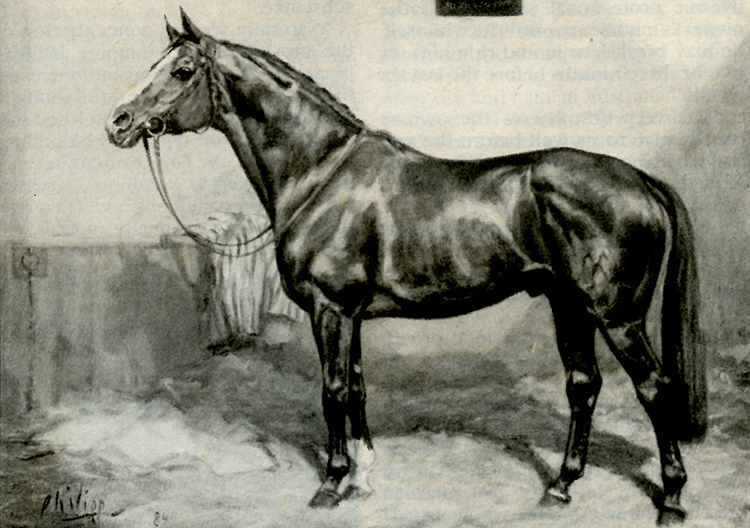
Absatz
“Now every breeder thinks, I must take my mare to the top stallion, and often they don’t realise that that stallion is not the right one for their mare. Breeding is not only to combine famous horses, breeding is more, it is the dream of looking to the possibility of genes of the mare, then thinking how must I combine this pedigree with another one to produce a good horse.”
You have always been a fan of Thoroughbred blood?
“When I was a student, I imported Thoroughbred horses from Great Britain. I had special agents in Ascot and Doncaster who knew that Werner was interested in good types, not too expensive and good walkers.”
“I would take my breakfast a little earlier, then on the airplane from Bremen to Heathrow in 55 minutes, a taxi for 20 minutes to Ascot, and could be home for my dinner that evening. I would buy four to six fillies, three years old, unraced… and they were not so expensive.”
Just before we visited Werner Schockemöhle, we had been at a stallion licensing, where one of the most spectacular moving stallions also had the most spectacular ‘winging’ of its front legs. The question was, how much of a conformational defect will you tolerate?
“A little bit is possible. Nobody is perfect.”
What defects are not acceptable?
“When it is too much, if it is too much. Normally the horse is going forward, but some horses are going in three dimensions and then it is not acceptable. I cannot tell what percentage, but you see it – I like a correct horse. People sometimes laugh about me, and say, he’s crazy, but in former times it was normal to only accept a correct horse as a stallion. But nowadays, they accept a little more. But in legs, you cannot make too many exceptions, it will always come back in the progeny.”
“I think now we have in our brain what is an ideal horse, and we have nearly the same ideas. I think there will be real progress because in the future there will not be a big change in what is wanted.”
“I see one problem and that is the influence of the Thoroughbred. There is no doubt that we need the Thoroughbred horse to produce our good riding horses, because the Thoroughbred gives us strong muscles, and a good front leg.”
“The Thoroughbred front leg is produced for the race track, and stays sound. It’s the right front leg for a riding horse. And we need the Thoroughbred to keep the balance of canter, the natural quality of canter. That is why we need the Thoroughbred – but now comes the problem – the Thoroughbred is not bred with the thought of making a riding horse, he is bred to race, and that is quite different. In breeding riding horses we make progress so we know what we do – while the Thoroughbred breeders have no idea of the qualities of the riding horse. There are many stories of disappointment with Thoroughbreds. Think of Marcio, Der Löwe and Pik As – all stood in Hanover, but all three very long ago. Now there is Lauries Crusador, and I hope he has the ability to produce dressage horses. I must say I have not seen a horse by him with such an ability to move as the horses I have seen by Der Löwe and Marcio.”
Marcio xx
“There was a big difference between Der Löwe and Marcio, Der Löwe was only successful with a few mares. He was not really a good producer of riding horses, a lot of them were crazy, and a lot of them were too little – it was with only one or two mares that he produced anything. Really it was only with one mare, a mare of unknown breeding, and with her, he produced Lugano I and Lugano 11. His influence is only through Lugano I and I I – and yet he was breeding for 20 years.”
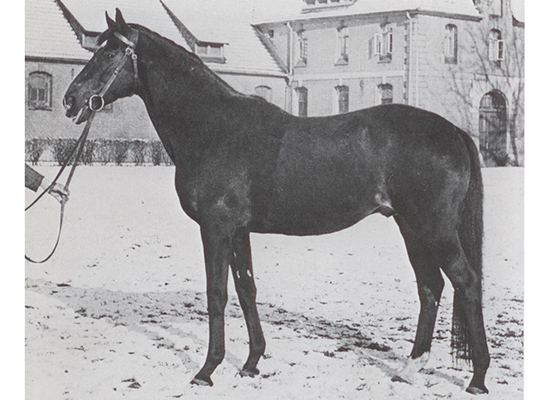
Der Löwe
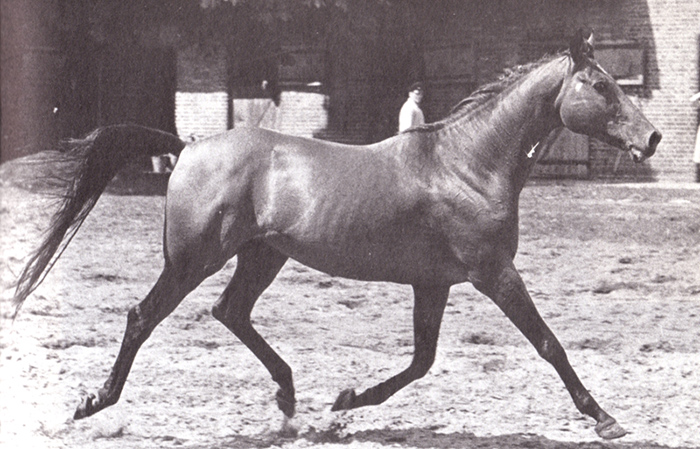
“Marcio was a different case. He was not a top producer of stallions, but he was a top producer of dressage horses in the first generation. Lots of them were fantastic movers.”
“From what I have seen so far of the Laurie’s Crusador horses, they haven’t had the moving ability of the Marcio horses. Laurie’s Crusador has been mated with the top mares and it should be much easier for him to produce good horses than in the time of Marcio. Marcio was often bred to very heavy and common mares.”
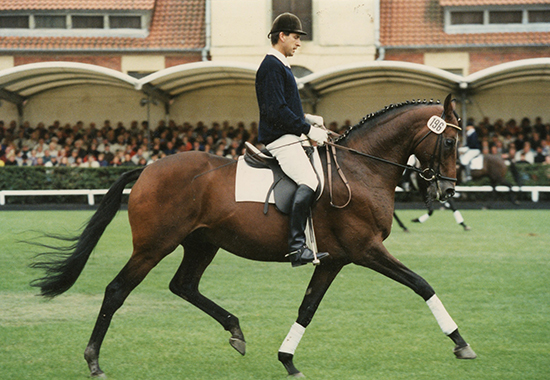
Laurie’s Crusador
“The problem is finding the right Thoroughbred stallion for our breeding. My opinion is that we must try to train the Thoroughbred stallion as a riding horse, and then when we can see him working as a riding horse, we know that his progeny will be riding horses. It is a hard way. Maybe you try ten and only one is good enough, maybe you try ten and none are good enough, but that is the only way to be successful.”
“I want a Thoroughbred who produces good horses in the first generation. It is also lazy in the brain to say, ‘okay in the first generation you cannot use them, you must wait for the second and third generation’. This is a wasteful, lazy way.”
“It’s a big problem finding Thoroughbred stallions, but you cannot breed without them. Here if you breed without Thoroughbreds, then from generation to generation, they become a little more heavy, and common. And you can only fight against this tendency by using Thoroughbred blood.”
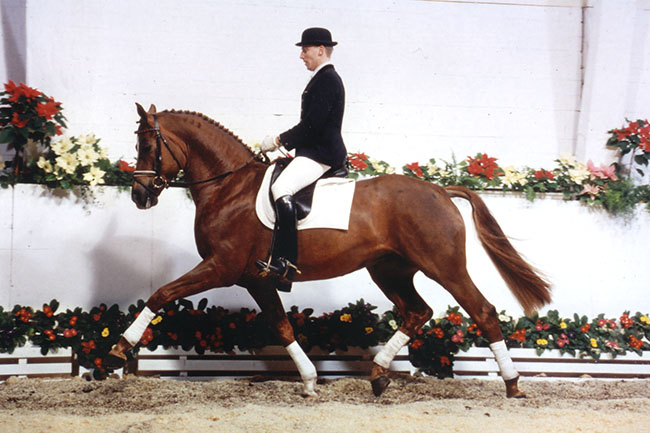
Alabaster
Alabaster was Werner’s pride and joy and the stallion stood at his private stud until Mr Schockemöhle’s death in 2000 when he transferred to the State Stud at Celle. Werner Schockemöhle was a great authority on the breeding of performance horses, and as he discussed his stallion’s breeding he would rush to his bookshelves to produce yet another photo or pedigree that added to the story, and it is the story of a breeder who followed his own vision.
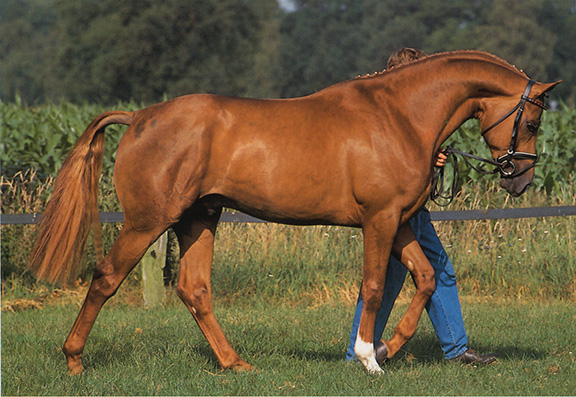
Alabaster
“I prefer some lines, no, not so much ‘lines’ as progeny of some special stallions. When I know the stallion, I know his pedigree and I know his progeny, and I have a good idea of what his progeny will be like.”
“Sometimes it is a little wrong to think only in lines. Sometimes when you see a horse, the influence comes much more from the bottom line. You sometimes have horses, that they say ‘this horse comes from the W line’ but when you see the horse you know that he has been produced from the influence of the genes of the other lines on his pedigree.”
“With Alabaster, it is a combination of several genes. The special factor with Alabaster is the clear influence from Abglanz, but he doesn’t have some of the mistakes that are usually associated with the Abglanz pedigree.”
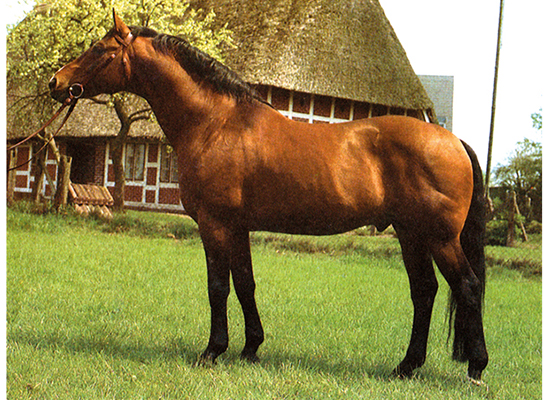
Argentan
“For twenty years I have judged the foals in the areas to the north, near Bargstedt, where Argentan stood. Then he was the most important stallion – for type – in Hanover. He made fantastic types, but he had the mistakes of Absatz/Abglanz. He was not so good in the shoulder, and often he was not good in the front legs, especially the fetlock and the pasterns. The fetlock was often not large enough, it was too light, and the pasterns were too short. Together that shortens the life of the front leg when it is used hard in the sport.”
“Alabaster doesn’t have this fault. He has a top front leg, and that is the influence of several other genes in his pedigree. For example, Busoni, the Thoroughbred horse, who is Alabaster’s great grand sire on the dam’s side, and was also the grand-sire of Gigolo. He was not discovered while he was a breeding stallion; he was never even discussed because he didn’t produce the best types. When he was gone, suddenly came Gigolo, and suddenly Busoni was interesting.”
Busoni – you need the Thoroughbred for soundness
“Alabaster is also influenced in his pedigree by the famous horse, Ferdinand. Ferdinand was a great producer of showjumpers, but sometimes he also produced very good dressage horses.”
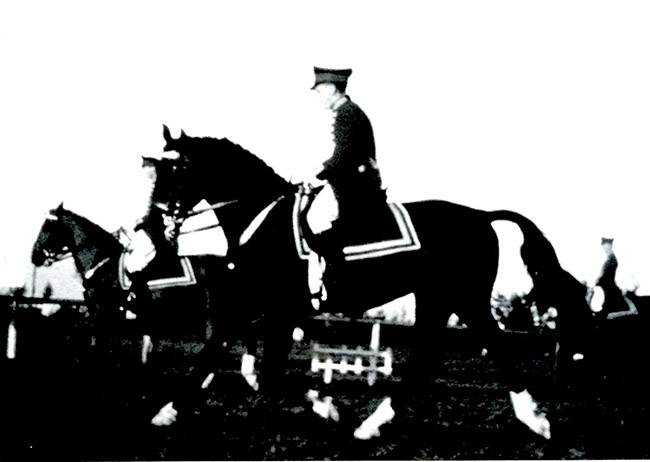
Ferdinand
“The first Olympic horse of my brother, Alwin, who won a team gold in 1960 at Rome, was Ferdl by Ferdinand. Ferdinand produced horses with a good canter and good walk. Reiner Klimke’s Olympic dressage horse, Mehmed was by Ferdinand. Another with very nice style was Hugo Simon’s Flipper – that was a horse, fifteen two and a half hands, but with the heart of a lion.”
Wendekreis – carrying on the Ferdinand line
“Ferdinand was a horse who only seldom found the right mare. He needed mares with blood, and there were few mares with blood that went to him.”
“When you look on the top line of Alabaster’s pedigree, you find Akzent 11, this is Absatz by Abglanz. Abglanz comes again on the pedigree on the bottom line, Aalfaenger is directly by Abglanz, and that is the explanation for the special type.”
“We often had problems with the walk with Abglanz progeny but this influence is balanced by the influence of others – Waidmannsdank, another Thoroughbred, and Busoni, and again Ferdinand. We see two times the influence of Ferdinand, on the sire line, Fernanda by Ferdinand, and on the dam’s side, Wendepunkt by Wendekreis by Ferdinand, and then Wendepunkt is in-bred to Ferdinand. Wendepunkt is out of Eingabe, by Einglas, by Athos, and the next dam on that side is Memoire by Marcio xx, out of Fernglück, by Ferdinand, so again we find Ferdinand. The dam of Einglas, Faki, was in her time the best mare in the whole of the breeding area. The sire of Einglas, Athos, was not so good but Faki was wonderful.”
“Together this makes the special pedigree of Alabaster, and maybe I recognized these things even more than the owner did when I bought him! He has the type of Abglanz, and when you breed him to mares with a little Trakehner influence, then it always comes back.”
You like to breed him over mares of Trakehner breeding?
“No, I don’t like so much the Trakehners. I come from another side of breeding, my brothers only discuss showjumpers. I don’t like horses that don’t have the possibility of being sporthorses. I think there are too many Trakehners without the ability for sport. For some years, I think the Trakehner breeders had it wrong in their heads, they thought when they had the nicest looking horses, they had the best horses. That was a mistake.”
“In the middle of the 1950’s the breeding of horses for agriculture was finished. Along came the tractor and all the breeders had to change their aims. For example in Oldenburg and Holstein they produced very heavy coach horses and for working on the farm. These horses were often over at the knee.”
“The Trakehner always had horses that had very flat gaits. It was discussed when I was a young man, and even then, I thought it was a terrible mistake. The flat gait is always wrong. The flat gait is always combined with a strong back, not enough elasticity. The Trakehner breeders however believed that the high movement in the trot was extremely wrong, and the flat movement was extremely good.”
“In reality, we needed more elastic gaits, and they must come more forward, not extremely high, but they must move over the knee – that is important for a showjumper, and it is important for a dressage horse. It is simple. It is necessary to jump clean, and it is important for piaffe and passage, but the Trakehner breeders went the wrong way, and because it is a closed stud book, it is very difficult for them to fix the problem.”
“For the last ten years, they have been aware of the problem, but it is difficult for them to find a solution because they have to use their own lines, and that is the big problem for the Trakehners, in showjumping as well as dressage.”
“For that reason, I don’t like to see too much Trakehner on the pedigree. When you look at Alabaster’s pedigree, you find Absatz in the third generation, and Absatz again in the fifth generation, and in my opinion that is close enough. You still get the wonderful type, and the Absatz is balanced by the other influences, Busoni, Ferdinand, Marcio, Waidmannsdank.”
“On the dam’s line we have Landeck, a half bred horse, by the Thoroughbred Lancelot – one of the best Thoroughbred stallions in the national stud before the last war. Because he was so good, the central management took him away from Celle, and put him into Trakehner breeding because they thought he was too good for the breeders in our area.”
Werner was very opposed to the instant experts on the breeding scene and this was his parting thought:
Today we have the problem where we have so many people who have read two or three books about horses, they have owned a horse for two years – and they know everything. No more questions, only answers. For thirty-five years I have tried to understand something about breeding, and I feel I have more questions than answers, every day I learn a new question. It’s not so easy, and that’s what makes breeding difficult.”
That was the view back in 1998 – for a breeder who is as up to date as the last World Young Dressage horse championships check out:
Hanoverian Breeder, Axel Windeler talks about generations of breeding
Or see what the mathematicians are thinking…
For a selection of the best European stallions available in Australia go to:


